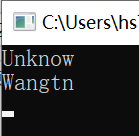构造函数初始化列表
对于一个类,我们需要给他赋初值,这时候构造函数就起到了这个作用,构造函数在类实体被建立的那一刻起就被调用并且给类赋上了初值,下面为类写两个构造函数
#include<iostream> #include<string> class Entity { private: std::string m_Name; public: Entity() { m_Name = "Unknow"; } Entity(const std::string& name) { m_Name = name; } const std::string &GetName()const { return m_Name; } }; int main() { Entity e0; std::cout << e0.GetName() << std::endl; Entity e1("Wangtn");//因为传入的数据时常量字符串,所以构造函数的输入也应该是const类型 std::cout << e1.GetName() << std::endl; std::cin.get(); }
可以看到打印结果

另外一种初始化方法是通过构造函数初始化链表来完成
#include<iostream> #include<string> class Entity { private: std::string m_Name; public: Entity() :m_Name("Unknow") { } Entity(const std::string& name) :m_Name(name) { } const std::string &GetName()const { return m_Name; } }; int main() { Entity e0; std::cout << e0.GetName() << std::endl; Entity e1("Wangtn");//因为传入的数据时常量字符串,所以构造函数的输入也应该是const类型 std::cout << e1.GetName() << std::endl; std::cin.get(); }
注意构造函数初始化链表的格式,而且当类中有多个成员变量时,使用构造函数初始化链表进行初始化时要按照变量的顺序来,而且如果有多个构造函数,所有的构造函数初始化变量的顺序必须相同。
#include<iostream> #include<string> class Example { public: Example() { std::cout << "Create Entity" << std::endl; } Example(int x) { std::cout << "Create Entity with" << x <<"!"<< std::endl; } }; class Entity { private: std::string m_Name; int x, y, z; Example m_Example;//1 public: Entity() { m_Name = "Unknow"; m_Example = Example(8);//2 } Entity(const std::string& name) { m_Name = name; } const std::string &GetName()const { return m_Name; } }; int main() { Entity e0; std::cin.get(); }

上面代码可以看到,我只新建了一个实体类Entity e0,但是却是用了两次Example的构造函数,也就是说Example这个类被创建了两次,第一次和第二次创建如程序注释所标注,如果使用构造函数初始化链表
#include<iostream> #include<string> class Example { public: Example() { std::cout << "Create Entity" << std::endl; } Example(int x) { std::cout << "Create Entity with" << x <<"!"<< std::endl; } }; class Entity { private: std::string m_Name; int x, y, z; Example m_Example; public: Entity() :m_Example(Example(8))//:m_Example(8) { m_Name = "Unknow"; } Entity(const std::string& name) { m_Name = name; } const std::string &GetName()const { return m_Name; } }; int main() { Entity e0; std::cin.get(); }

可以看到Example只建立了一次,注释后的写法结果是一样的。所以结论就是没有理由不使用构造函数初始化链表,他可以简化代码,节约资源,并且不会出错
无情的摸鱼机器




 浙公网安备 33010602011771号
浙公网安备 33010602011771号